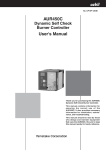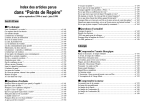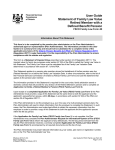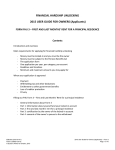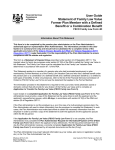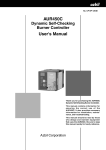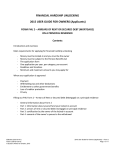Download User Guide - FSCO Family Law Form 1
Transcript
Financial Services Commission of Ontario User Guide Application for Family Law Value FSCO Family Law Form 1 IMPORTANT You may want to get legal advice before completing the Application Form. You (the Plan Member or the spouse/former spouse who is/was married to the Plan Member) must complete the Application Form in order to get the Family Law Value of a pension. The Ontario Pension Benefits Act requires that the Family Law Value be calculated before a Plan Member’s pension can be divided between a Plan Member and his or her spouse/former spouse. [Note: “Family Law Value” means the “imputed value” under the Ontario Pension Benefits Act.] If you are/were in a common-law relationship, only the Plan Member may complete the Application Form. You cannot use the Application Form if you have a court order, family arbitration award or domestic contract (e.g. separation agreement) that was made before January 1, 2012, and dealt with pension assets. You must complete the Application Form, provide all required documents and pay the fee (if any) in order to get your Family Law Value from the pension plan administrator (Plan Administrator). Contact the Plan Administrator for fee information. See Part B (Pension Plan Information) below for instructions on how to find out who the Plan Administrator is if you do not know. Send your completed Application Form to the Plan Administrator. DO NOT SEND YOUR APPLICATION FORM TO THE FINANCIAL SERVICES COMMISSION OF ONTARIO (FSCO). Information required in the Application Form is set out in sections 21 and 22 of Ontario Regulation 287/11. Part A Applicant Information P Identify who you are by filling in your name and checking the box that applies. You must be either the Plan Member or the spouse/former spouse who is or was married to the Plan Member. If you are the common-law spouse/former spouse of the Plan Member, you cannot use the Application Form. Only the Plan Member in a common-law relationship may use the Application Form. If you are the person acting on behalf of the Plan Member or the spouse/former spouse of a Plan Member under a power of attorney for property, identify yourself under Part C or Part D of the Application Form and attach a certified copy of the power of attorney for property. You may complete the Application Form and sign on behalf of the Plan Member or the spouse/former spouse of the Plan Member. If you are the person acting on behalf of the Plan Member or the spouse/former spouse of a Plan Member under a court order, identify yourself under Part C or Part D of the Application Form and attach a certified copy of the court order. You can only complete the Application Form and sign on behalf of the Plan Member or the spouse/former spouse of the Plan Member if you have been given this authority under the court order. Effective (2013-01-01) FSCO (1264E.2-I) © Queen's Printer for Ontario, 2013 User Guide for FSCO Family Law Form 1 Page 1 of 6 Part B Pension Plan Information Identify the pension plan. The name and registration number of the pension plan will usually be found in pension plan brochures, member booklets and annual pension statements given to the Plan Member. The Plan Administrator can also give you this information. If you know the name of the employer, union or professional association sponsoring the pension plan, the plan registration number or plan name, you can also search for information about the Plan Administrator on FSCO’s website (www.fsco.gov.on.ca). Go to the FSCO Pension Plan Information Access web page and click on Pension Plan Information Access. Please note that not all pension plans are listed on FSCO’s website. If you need further assistance in obtaining information about a pension plan that is registered with FSCO, contact FSCO at (416) 226-7776 or toll-free at 1-800-668-0128 (extension 7776). Part C Plan Member Information You MUST complete this section and provide a certified copy of proof of the Plan Member’s date of birth, even if you are the Plan Member’s spouse/former spouse. The Plan Administrator must have this information to calculate the Family Law Value. A birth certificate, baptismal certificate and passport are the most commonly accepted documents for proof of a date of birth. If you do not have any of these documents, contact the Plan Administrator to find out what other document(s) are acceptable as proof of the date of birth. A “certified copy” is a copy of the original document that has been certified as being a true copy of the original document. Typically, people who provide certification include lawyers and notaries. Contact the Plan Administrator to find out if it will accept certified copies from other people (e.g. Human Resource personnel). The Plan Member’s employee or pension plan identification number is the number assigned to the Plan Member for identification purposes by the Plan Administrator or employer. The Plan Member’s identification number can usually be found in the annual pension statements given to the Plan Member. The Plan Administrator may also give you this information. If you do not know this number, you may indicate that you do not know this information. Provide the Plan Member’s e-mail address if you know this information. Contact Person for the Plan Member (optional): You do not have to have a contact person. If you need help talking to the Plan Administrator, however, you may appoint someone you know and trust to communicate with, receive and/or request information from the Plan Administrator about the calculation and division of the Family Law Value on your behalf. It may be helpful to have a contact person if you have difficulty communicating in English, for example. Your contact person may be your lawyer or another person such as a family member or a friend. However, your contact person can only sign on your behalf if he/she has been granted power of attorney for property, or is authorized to do so by a court order. If you want to appoint a contact person, you need to complete the Contact Person Authorization (FSCO Family Law Form 3), and send this form to the Plan Administrator along with the Application for Family Law Value (FSCO Family Law Form 1). If you decide to change your contact person, you need to provide the Plan Administrator with another Contact Person Authorization (FSCO Family Law Form 3). Effective (2013-01-01) FSCO (1264E.2-I) © Queen's Printer for Ontario, 2013 User Guide for FSCO Family Law Form 1 Page 2 of 6 If you are the Plan Member completing the Application Form and do not know how to get in contact with your spouse/former spouse, or if you only communicate with him/her through a lawyer, you should provide enough contact information about your spouse’s/former spouse’s contact person in order that the Plan Administrator will be able to get in contact with him/her. By law, the Plan Administrator must send both you and your spouse/former spouse a Statement of Family Law Value (FSCO Family Law Form 4) regardless of who completes the Application Form. This Statement provides information about the Family Law Value and must be provided to both of you at the same time. Note that your Application Form will not be considered complete unless the Plan Administrator has all the information required to calculate the Family Law Value and provide a copy of the Statement of Family Law Value (FSCO Family Law Form 4) to both you and your spouse/former spouse. Part D Spouse/Former Spouse of the Plan Member Information You MUST complete this section and provide a certified copy of proof of the date of birth of the spouse/former spouse of the Plan Member, even if you are the Plan Member. The Plan Administrator must have this information to calculate the Family Law Value. A birth certificate, baptismal certificate and passport are the most commonly accepted documents for proof of a date of birth. If you do not have any of these documents, contact the Plan Administrator to find out what other document(s) are acceptable as proof of the date of birth. A “certified copy” is a copy of the original document that has been certified as being a true copy of the original document. Typically, people who provide certification include lawyers and notaries. Contact the Plan Administrator to find out if it will accept certified copies from other people (e.g. Human Resource personnel). Provide the spouse’s/former spouse’s e-mail address if you know this information. If the Plan Member is a retired member, indicate if the spouse/former spouse in Part D is the same person as the Plan Member’s spouse on the date the Plan Member retired. Contact Person for the Spouse/Former Spouse of the Plan Member (optional): You do not have to have a contact person. If you need help talking to the Plan Administrator, however, you may appoint someone you know and trust to communicate with, receive and/or request information from the Plan Administrator about the calculation and division of the Family Law Value on your behalf. It may be helpful to have a contact person if you have difficulty communicating in English, for example. Your contact person may be your lawyer or another person such as a family member or a friend. However, your contact person can only sign on your behalf if he/she has been granted power of attorney for property, or is authorized to do so by a court order. If you want to appoint a contact person, you need to complete the Contact Person Authorization (FSCO Family Law Form 3), and send this form to the Plan Administrator along with the Application for Family Law Value (FSCO Family Law Form 1). If you decide to change your contact person, you need to provide the Plan Administrator with another Contact Person Authorization (FSCO Family Law Form 3). If you are the spouse/former spouse of the Plan Member completing the Application Form and do not know how to get in contact with the Plan Member, or if you only communicate with him/her through a lawyer, you should provide enough contact information about the Plan Member’s contact person in order that the Plan Administrator will be able to get in contact with him/her. By law, the Plan Administrator must send both you and the Plan Member a Statement of Family Law Value (FSCO Family Law Form 4) regardless of who completes the Application Form. This Statement provides information about the Family Law Value and must be provided to both of you at the same time. Note that your Application Form will not be considered complete unless the Plan Administrator has all the information required to calculate the Family Law Value and provide a copy of the Statement of Family Law Value (FSCO Family Law Form 4) to both you and the Plan Member. Effective (2013-01-01) FSCO (1264E.2-I) © Queen's Printer for Ontario, 2013 User Guide for FSCO Family Law Form 1 Page 3 of 6 Part E Starting Date of Spousal Relationship (Married or Common-Law) The “starting date” of your spousal relationship is explained in section 17 of Ontario Regulation 287/11. You and your spouse/former spouse must provide the starting date of your spousal relationship (which may be a date that was determined by a court). For married spouses/former spouses, the starting date of your spousal relationship will be your marriage date unless you have agreed otherwise in a domestic contract or a different date was determined by the arbitrator in your family arbitration award. The starting date cannot be a date that is earlier than the date when you and your spouse/former spouse started living together in a common-law relationship, or later than your marriage date. You must provide proof of the starting date of your spousal relationship. The only acceptable forms of proof are: • • • a certified copy of your marriage certificate; or a joint declaration signed by you and your spouse/former spouse (complete Joint Declaration of Period of Spousal Relationship (FSCO Family Law Form 2); or a certified copy of a court order, family arbitration award or domestic contract. A “certified copy” is a copy of the original document that has been certified as being a true copy of the original document. Typically, people who provide certification include lawyers and notaries. Contact the Plan Administrator to find out if it will accept certified copies from other people (e.g. Human Resource personnel). IMPORTANT: Any change to the starting date of your spousal relationship will require you to file a new Application Form and must be accompanied by all required documents and the fee (if any). Part F Separation Date (Family Law Valuation Date) You and your spouse/former spouse must agree on your Family Law Valuation Date (separation date) before your Family Law Value can be calculated. If you and your spouse/former spouse cannot agree on or have not determined your separation date, do not complete this Part F. Instead, you and your spouse/former spouse may complete Appendix A of the Application Form (see instructions for Appendix A below) by selecting two possible valuation dates. The Plan Administrator will not be able to calculate your Family Law Value without your separation date. If you provide the wrong date or a date that both of you have not agreed to, you will have to start over with a new application and pay the fee (if any) again. Family Law Valuation Date is defined in section 67.1(1) of the Ontario Pension Benefits Act. (a) Married Spouses If you are/were married, the Family Law Valuation Date is your valuation date under Part 1 (Family Property) of the Ontario Family Law Act. This date is the earliest of the following, in accordance with section 4(1) of the Ontario Family Law Act: 1. The date you separated from your spouse and there was no reasonable prospect that you would resume cohabitation. 2. The date your divorce was granted. 3. The date your marriage was declared a nullity. 4. The date one of you commenced an application based on subsection 5(3) (improvident depletion) that was subsequently granted. 5. The date before the date on which one of you died leaving the other spouse surviving. Effective (2013-01-01) FSCO (1264E.2-I) © Queen's Printer for Ontario, 2013 User Guide for FSCO Family Law Form 1 Page 4 of 6 (b) Common-Law Spouses Your Family Law Valuation Date is the date you separated from your spouse and there was no reasonable prospect that you would resume cohabitation. You must provide proof of the date when you separated from your spouse/former spouse. The only acceptable forms of proof are: • • • a joint declaration signed by you and your spouse/former spouse (complete Joint Declaration of Period of Spousal Relationship (FSCO Family Law Form 2)); Appendix A of the Application Form; or a certified copy of a court order, family arbitration award or domestic contract. A “certified copy” is a copy of the original document that has been certified as being a true copy of the original document. Typically, people who provide certification include lawyers and notaries. Contact the Plan Administrator to find out if it will accept certified copies from other people (e.g. Human Resource personnel). IMPORTANT: Any change to the date when you separated from your spouse/former spouse will require you file a new Application Form and must be accompanied by all required documents and the fee (if any). Part G Documents and Fee The Plan Administrator will not provide the Family Law Value unless you provide the Plan Administrator with a complete application, all required documents and pay the fee (if any) charged by the Plan Administrator. Contact the Plan Administrator to find out what the fee is and how you should pay it. The Plan Administrator may be required to charge Harmonized Sales Tax (HST) on the fee. Part H Declaration You must sign, print your name and date the Application Form in the presence of a witness. Note that your witness: • • • • may not be your spouse/former spouse; must be at least 18 years of age; must see you sign the Application Form; and, must also sign, print his/her name and date this Part of the Application Form immediately after seeing you sign and date the Application Form (this means that you and your witness must sign on the same date). If you are acting on behalf of the Plan Member or the spouse/former spouse of the Plan Member under a power of attorney for property or under a court order, you may sign on his/her behalf. A contact person cannot sign the Application Form unless the contact person also has power of attorney for property, or is authorized to do so by a court order. Once the Plan Administrator receives your complete application, including all required documents and the fee (if any), you and your spouse/former spouse will receive a Statement of Family Law Value (FSCO Family Law Form 4) from the Plan Administrator within 60 days. Effective (2013-01-01) FSCO (1264E.2-I) © Queen's Printer for Ontario, 2013 User Guide for FSCO Family Law Form 1 Page 5 of 6 Appendix A - Request for Two Family Law Values Do not complete Appendix A if you have completed Part F [Separation Date (Family Law Valuation Date)] of this Application Form. You and your spouse/former spouse may complete Appendix A if you cannot agree on or have not determined your separation date (Family Law Valuation Date). If this is the case, Appendix A will serve as proof of your Family Law Valuation Date (separation date) for purposes of the Application Form. You and your spouse/former spouse must sign, print your names and date this Appendix A in the presence of a witness. You may each have your own witness. Note that your witness: • • • • may not be your spouse/former spouse; must be at least 18 years of age; must see you sign the Application Form; and, must also sign, print his/her name and date this Part of the Application Form immediately after seeing you sign and date the Application Form (this means that you and your witness must sign on the same date). Upon receiving a complete application including the completed Appendix A, the Plan Administrator will provide you and your spouse/former spouse with two Statements of Family Law Value (FSCO Family Law Form 4), based on the two proposed separation dates. Your application will be treated as two separate applications. The Plan Administrator may charge two separate fees for the application. Before the Family Law Value can be divided, you and your spouse/former spouse will have to confirm to the Plan Administrator, which of the two proposed dates should be used as your actual separation date by completing an Application to Transfer the Family Law Value (FSCO Family Law Form 5) or Application to Divide a Retired Member’s Pension (FSCO Family Law Form 6), as applicable. Effective (2013-01-01) FSCO (1264E.2-I) © Queen's Printer for Ontario, 2013 User Guide for FSCO Family Law Form 1 Page 6 of 6







